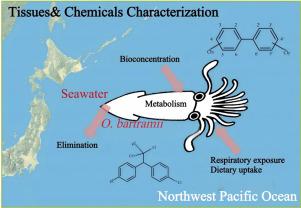Disparities in bioaccumulation of chlorinated organic pollutants in O. bartramii and seawater from the Northwest Pacific Ocean: Compound – specific mechanisms and health risks
IF 4.9
3区 环境科学与生态学
Q1 ENVIRONMENTAL SCIENCES
引用次数: 0
Abstract
Chlorinated organic pollutants (COPs), including organochlorine pesticides (OCPs) and polychlorinated biphenyls (PCBs), persist in marine ecosystems despite global restrictions, posing risks to both organisms and human health. This study systematically investigated the bioaccumulation of 24 COPs in seawater and tissues (muscle, stomach, digestive gland) of the neon flying squid (Ommastrephes bartramii) from the Northwest Pacific Ocean. In O. bartramii, ∑OCPs (8.78–353.72 ng g−1 lw, 78.77 ng g−1 lw) exceeded ∑PCBs (2.50–168.25 ng g−1 lw, 31.59 ng g−1 lw), especially in the digestive gland, while in seawater, ∑PCBs (131.67–445.27 pg L−1, 282.71 pg L−1) surpassed ∑OCPs (40.92–98.41 pg L−1, 57.67 pg L−1). Principal component analysis (PCA) and isomer ratios demonstrated distinct pollutant profiles between seawater and tissues, reflecting fundamentally divergent pollution sources and environmental behaviors mediated by biological metabolism and enrichment processes. Bioaccumulation factors (BAFs) for β – HCH, γ – HCH and α – chlordane far exceeded previous reports, suggesting distinct sources or accumulation. Muscle and digestive gland held over 90 % of the total load, acting as main storage sites. Health risk assessment confirmed the safety of O. bartramii consumption, with carcinogenic risk indices (CRI = 0–1.8 × 10−5) and exposure risk indices (ERI = 0–0.45) below thresholds. These findings enhance understanding of COP bioaccumulation mechanisms and inform policies for global marine pollution control.

西北太平洋bartramii和海水中氯代有机污染物生物积累的差异:化合物特异性机制和健康风险。
尽管有全球限制,但包括有机氯农药和多氯联苯在内的氯化有机污染物仍然存在于海洋生态系统中,对生物和人类健康构成风险。本研究系统地研究了24种COPs在西北太平洋飞鱼(Ommastrephes bartramii)的海水和组织(肌肉、胃、消化腺)中的生物积累。在bartramii中,∑OCPs (8.78 ~ 353.72 ng g-1 lw, 78.77 ng g-1 lw)超过∑PCBs (2.50 ~ 168.25 ng g-1 lw, 31.59 ng g-1 lw),特别是在消化腺中,∑PCBs (131.67 ~ 445.27 pg L-1, 282.71 pg L-1)超过∑OCPs (40.92 ~ 98.41 pg L-1, 57.67 pg L-1)。主成分分析(PCA)和同分异构体比值显示了海水和组织之间不同的污染物分布,反映了生物代谢和富集过程介导的污染源和环境行为的根本差异。β -六氯环己烷、γ -六氯环己烷和α -氯丹的生物积累因子(baf)远远超过以往的报道,表明其来源或积累不同。肌肉和消化腺占总负荷的90%以上,是主要的储存场所。健康风险评价结果表明,食用巴乐米是安全的,致癌风险指数(CRI = 0 ~ 1.8 × 10-5)和暴露风险指数(ERI = 0 ~ 0.45)均低于阈值。这些发现增强了对COP生物积累机制的认识,并为全球海洋污染控制政策提供了信息。
本文章由计算机程序翻译,如有差异,请以英文原文为准。
求助全文
约1分钟内获得全文
求助全文
来源期刊

Marine pollution bulletin
环境科学-海洋与淡水生物学
CiteScore
10.20
自引率
15.50%
发文量
1077
审稿时长
68 days
期刊介绍:
Marine Pollution Bulletin is concerned with the rational use of maritime and marine resources in estuaries, the seas and oceans, as well as with documenting marine pollution and introducing new forms of measurement and analysis. A wide range of topics are discussed as news, comment, reviews and research reports, not only on effluent disposal and pollution control, but also on the management, economic aspects and protection of the marine environment in general.
 求助内容:
求助内容: 应助结果提醒方式:
应助结果提醒方式:


